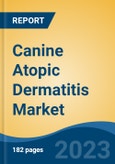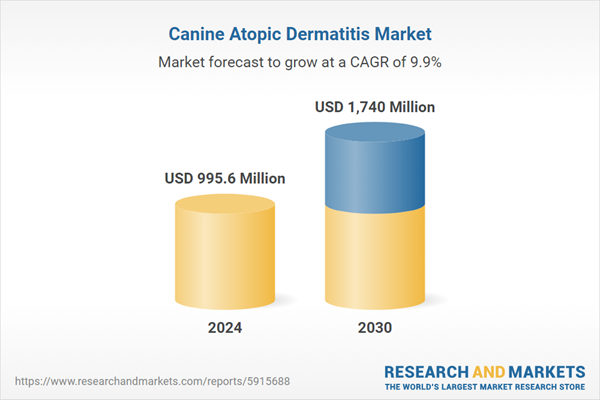Speak directly to the analyst to clarify any post sales queries you may have.
10% Free customizationThis report comes with 10% free customization, enabling you to add data that meets your specific business needs.
Key Market Drivers:
Rising Pet Ownership and Humanization: The global pet industry has seen significant growth, largely due to an increasing number of pet owners worldwide. Along with this trend, pets are increasingly being regarded as family members rather than just companions, a shift that has major implications for various pet-related markets, including the canine atopic dermatitis market. The 2021-2022 American Pet Products Association (APPA) National Pet Owners Survey revealed that dog owners spent an average of USD 458 on surgical veterinary visits and USD 242 on routine visits.This growing investment in pet health, combined with increasing awareness of canine health issues, is driving demand for advanced treatments, including those for conditions such as canine allergic dermatitis, thereby fostering growth in the veterinary care market. In particular, the rise in pet ownership has led to increased demand for healthcare products and services, including treatments for chronic conditions like atopic dermatitis. As pets are increasingly seen as family members, pet owners are more likely to prioritize high-quality healthcare, including preventive measures and ongoing management of conditions such as canine atopic dermatitis.
Key Market Challenges:
Misdiagnosis and Underdiagnosis: A key challenge in managing canine atopic dermatitis is the potential for misdiagnosis or underdiagnosis. Symptoms such as itching, redness, and skin irritation often overlap with other skin conditions, making accurate diagnosis essential. Failing to identify atopic dermatitis can result in improper treatments or a lack of intervention, potentially worsening the dog's condition.Varied Triggers: Canine atopic dermatitis has various triggers, including environmental allergens, food sensitivities, and genetic factors. Identifying the specific trigger for each dog can be challenging, which makes developing a universal treatment plan difficult. This variability requires a personalized approach to treatment and care.
Compliance and Duration of Treatment: Ensuring compliance with prescribed treatment regimens over the long term can be a challenge for both pet owners and veterinarians. The ongoing nature of the condition necessitates sustained management, which may impact adherence to prescribed therapies.
Key Market Trends:
Advancements in Immunotherapy: Allergen-specific immunotherapy (ASIT) is becoming more refined and accessible. The development of more accurate allergy testing methods and innovative ASIT treatments is expected to enhance the management of atopic dermatitis by targeting the specific allergens that cause the condition in each dog.Targeted Therapies: Pharmaceutical advancements are leading to the development of targeted therapies that address the underlying causes of canine atopic dermatitis. These treatments aim to reduce the need for long-term symptom management, ultimately improving the quality of life for affected dogs.
Holistic and Alternative Therapies: Holistic and alternative treatments, such as acupuncture, herbal remedies, and physical rehabilitation, are gaining popularity as complementary options for managing atopic dermatitis. These approaches are being recognized for their potential to improve overall well-being and provide additional management options for pet owners seeking non-traditional therapies.
Key Market Players:
- Zoetis Inc.
- Elanco Animal Health Inc.
- Virbac SA
- Toray Industries Inc.
- AB Science SA
- Boehringer Ingelheim GmbH
- Kindred Biosciences Inc.
Report Scope:
This report segments the global Canine Atopic Dermatitis Market into multiple categories, providing valuable insights into industry trends and forecasts. The market is segmented as follows:
By Product:
- Glucocorticoids
- Antihistamines
- Immunosuppressants
- Monoclonal Antibodies (MAbs)
- Others
By Mode of Administration:
- Topical
- Oral
- Injectable
By Distribution Channel:
- Veterinary Hospitals/Clinics
- Retail
- E-commerce
By Region:
North America:
United States, Canada, MexicoEurope:
Germany, United Kingdom, France, Italy, SpainAsia-Pacific:
China, Japan, India, Australia, South KoreaSouth America:
Brazil, Argentina, ColombiaMiddle East & Africa:
South Africa, Saudi Arabia, UAE, KuwaitCompetitive Landscape:
This section offers a detailed analysis of the major players operating in the global Canine Atopic Dermatitis Market.Available Customizations:
TechSci Research provides customization options for this market report based on specific company requirements. Customization options include detailed profiles of additional market players (up to five).This product will be delivered within 1-3 business days.
Table of Contents
Companies Mentioned
- Zoetis Inc
- Elanco Animal Health Inc
- Virbac SA
- Toray Industries Inc
- AB Science SA
- Boehringer Ingelheim GmbH
- Kindred Biosciences Inc
Table Information
| Report Attribute | Details |
|---|---|
| No. of Pages | 185 |
| Published | March 2025 |
| Forecast Period | 2024 - 2030 |
| Estimated Market Value ( USD | $ 995.6 Million |
| Forecasted Market Value ( USD | $ 1740 Million |
| Compound Annual Growth Rate | 9.9% |
| Regions Covered | Global |
| No. of Companies Mentioned | 7 |









